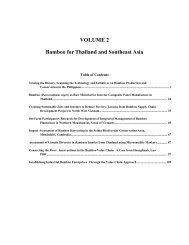WBC-VIII-Vol.4 – Resources – Forestry, Plantations and ... - BambuSC
WBC-VIII-Vol.4 – Resources – Forestry, Plantations and ... - BambuSC
WBC-VIII-Vol.4 – Resources – Forestry, Plantations and ... - BambuSC
You also want an ePaper? Increase the reach of your titles
YUMPU automatically turns print PDFs into web optimized ePapers that Google loves.
Bamboo has called the poorperson’s gift to mankind <strong>and</strong> the quality <strong>and</strong> availability both caused <strong>and</strong> effects in<br />
the larger socio-cultural <strong>and</strong> economic dimensions of a community (Behari, 2006). It has been estimated that the<br />
combined value of international <strong>and</strong> commercial consumption of bamboo is to the tune of US $ 10 billion in the<br />
world (Borah, et al., 2008). Such a large number of economic impact on results in important resources for local<br />
dwelling people who are easy to approach <strong>and</strong> use. The over-exploitation of timber also focused research on<br />
bamboo production, cultivation <strong>and</strong> utilization in recent years (Rao, et al., 2008). Therefore, bamboo is worth<br />
for thinking the way of usage as a large amount of renewable local resources.<br />
Research purpose <strong>and</strong> method<br />
Bamboo is used in domestic needs for house construction, fuel, fodder, food, tools, religious ceremony, <strong>and</strong><br />
previous study already analyze the resource, physical characteristics, utility, market values <strong>and</strong> propagation<br />
success in Manipur, India (Singh, et al., 2003). It is extremely versatile, strong, renewable <strong>and</strong> environment<br />
friendly plant species (Nath, et al., 2008). In order to use this useful resource, it would be needed the financial<br />
support of administrative sector <strong>and</strong> its operation of local people, because the government has the power to tax<br />
the primary products or subsidize a process (Chundamannil, 1990), <strong>and</strong> it is critical problem for local area to<br />
accept the related policies. In India, the National Bamboo Mission (NBM) provides for resource creation right<br />
from nursery state to high-end value additions <strong>and</strong> marketing of bamboo products (Gupta, 2008). Mizoram state<br />
also established original bamboo policy in 2002 under the rich in bamboo forest (Bamboo Development Cell,<br />
2004). Moreover, as it is predicted before, the gregarious bamboo flowering occurred <strong>and</strong> has economic impact<br />
on the people of this state (Lalnunmawia, et al., 2005). Especially, the people who depend on the bamboo<br />
resources will have faced serious problem.<br />
In this paper, the bamboo resource of Mizoram was identified in India through analyzing of bamboo policies <strong>and</strong><br />
contents of them. The operational system of policies <strong>and</strong> administrative organization is also examined to use the<br />
resources fluently even if bamboo flowering would occur.<br />
Bamboo <strong>Resources</strong><br />
The gr<strong>and</strong> total of bamboo area was estimated 96,071km 2 <strong>and</strong> the percentage share of it was 14.2% compared<br />
with forest area (Table 1). As shown in this table, Mizoram was 49.3% relatively larger bamboo area than other<br />
states. These states amounted to 84.5% of bamboo area in India <strong>and</strong> 4 North East states contain this list. It was<br />
indicated that bamboo resources were unevenly distributed.<br />
<strong>VIII</strong> World Bamboo Congress Proceedings Vol 4-82




